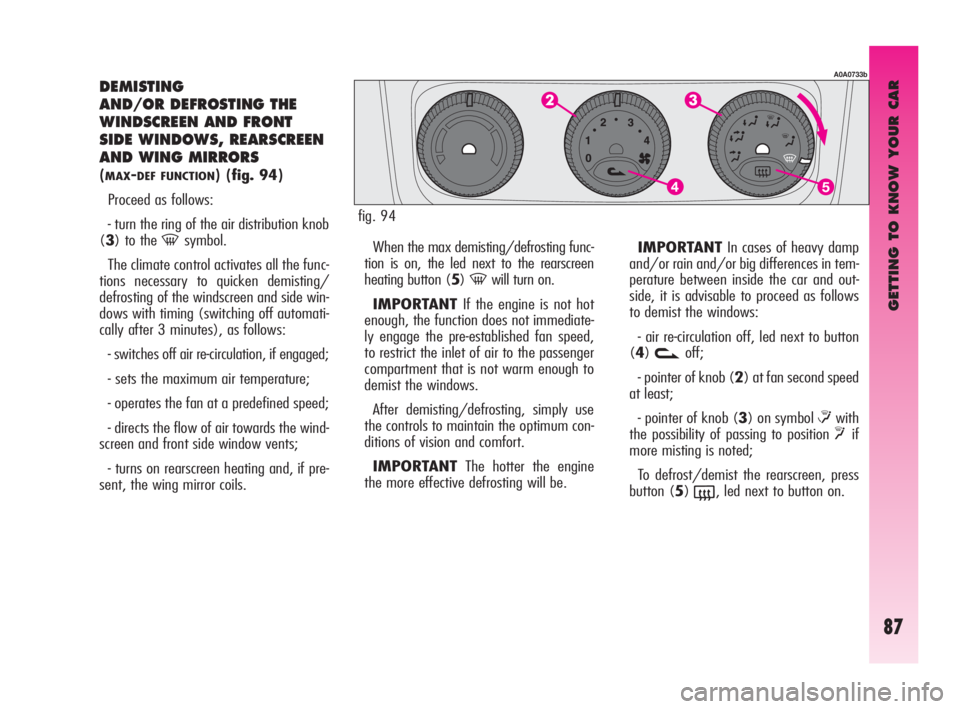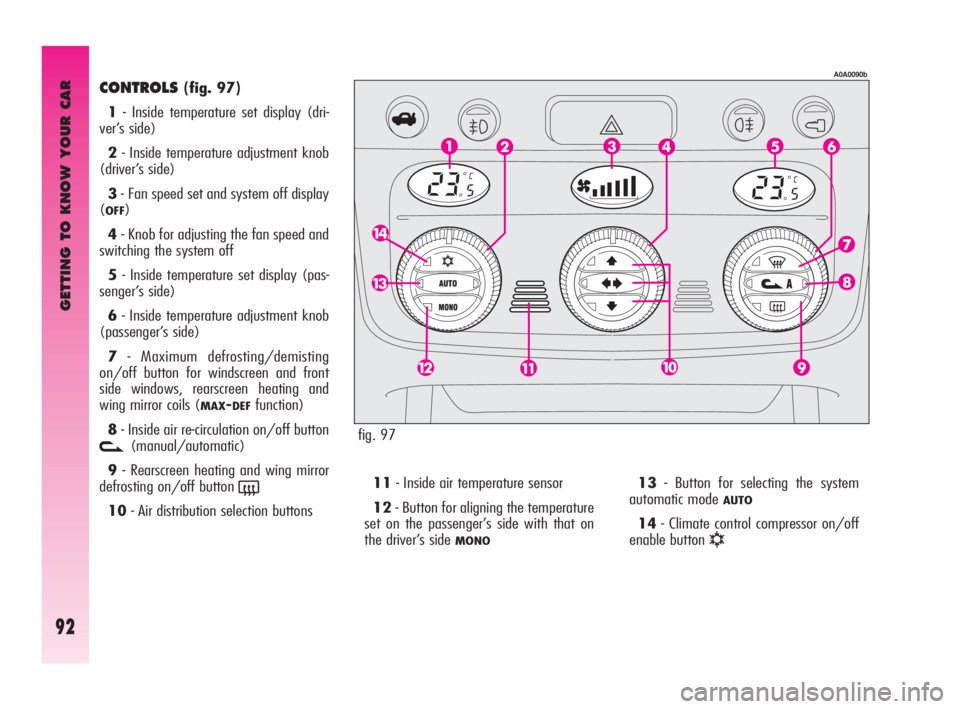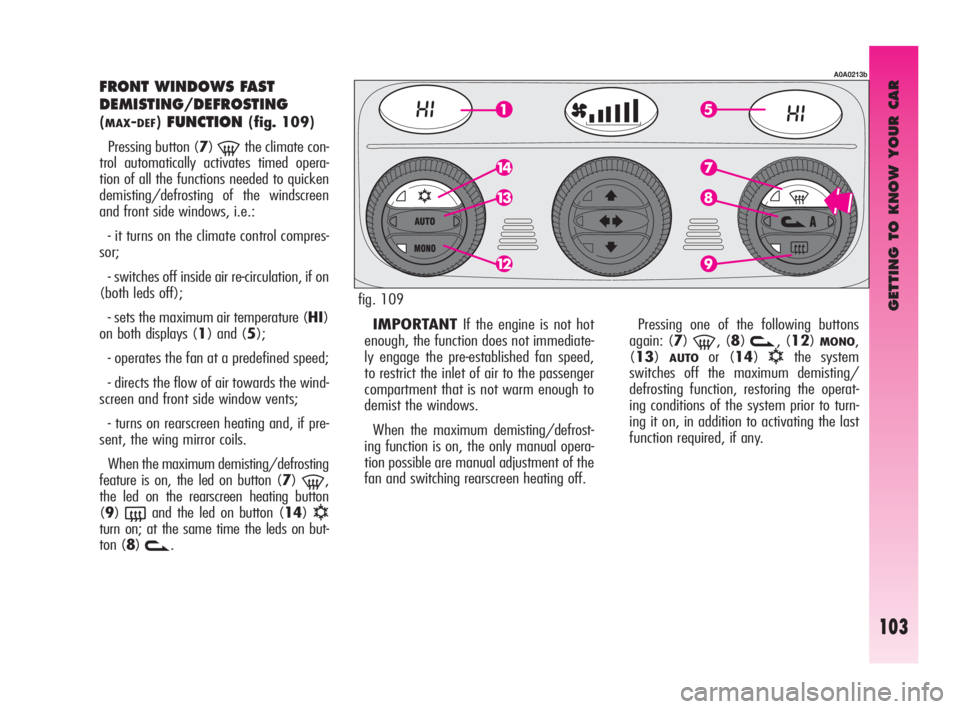mirror Alfa Romeo GT 2010 Owner handbook (in English)
[x] Cancel search | Manufacturer: ALFA ROMEO, Model Year: 2010, Model line: GT, Model: Alfa Romeo GT 2010Pages: 271, PDF Size: 5.34 MB
Page 25 of 271

GETTING TO KNOW YOUR CAR
23
REAR-VIEW MIRROR
ADJUSTMENT
INNER
The mirror, fitted with a safety device that
causes it to be released in the event of a
violent crash, can be moved using the lever
(A-fig. 28) to two different positions, nor-
mal or antiglare.
fig. 28
A0A0039b
Folding(fig. 30)
– In the event of need (for example when
the mirror causes difficulty in narrow spaces)
it is possible to fold the mirror moving it from
position (A) to position (B).
fig. 30
A0A0041b
When driving the mirrors
should always be in posi-
tion (A).
As the driver’s wing mir-
ror is curved, it may slight-
ly alter the perception of
distance.
OUTER
Electric adjustment (fig. 29)
– use the switch (A) to select the mirror
required (right or left);
– pressing the button (B) in one of the
four directions, move the mirror selected pre-
viously;
– position the switch (A) in the interme-
diate locking position.
IMPORTANTAdjustment is possible on-
ly with the ignition key at MAR.
fig. 29
A0A0040b
Page 26 of 271

GETTING TO KNOW YOUR CAR
24fig. 33
A0A0043b
POWER WINDOWS
IMPORTANTWith the ignition key at
STOPor removed, the power windows re-
main activated for about 3 minutes and are
deactivated immediately the moment a door
is opened.Driver’ side
(fig. 33)
The driver’s door panel contains the but-
tons that control the following windows,
with the ignition key at MAR:
A- left front window
B- right front window.
Press the button to lower the window. Pull
to raise it. Defrosting/demisting(fig. 31-32)
The electric mirrors are fitted with heat-
ing coils which come into operation with
rearscreen heating pressing the button (A)
thereby defrosting and/or demisting the mir-
rors.
IMPORTANTThe function is timed and
automatically switched off after a few min-
utes.
fig. 32
A0A0612b
fig. 31
A0A0042b
Page 50 of 271

GETTING TO KNOW YOUR CAR
48
At each start, the rain sensor automatically
stabilises at a temperature of about 40°C
to eliminate any condensation from the con-
trol surface and prevent the formation of ice.
The rain sensor is able to detect and au-
tomatically adapt to the presence of the fol-
lowing particular conditions which require
different sensitivity:
– impurities on the control surface (salt,
dirt, etc.);
– streaks of water caused by worn wiper
blades;
– difference between day and night (the
human eye is more disturbed during the
night by the wet glass surface). Rain sensor (fig. 64)
The rain sensor (A), fitted only on cer-
tain versions, is an electronic device com-
bined with the windscreen wiper which has
the purpose of automatically adjusting the
number of wipes during intermittent opera-
tion to the intensity of the rain.
All the other functions controlled by the
right-hand lever remain unchanged.
The rain sensor is activated automatically
moving the right-hand lever to position (B-
fig. 62) and it has a range of adjustment
that gradually varies between wiper sta-
tionary (no wiping) when the windscreen is
dry, to wiper at first continuous speed (con-
tinuous, slow) with heavy rain.Turning the knurled ring (F-fig. 62) it
is possible to increase the sensitivity of the
rain sensor, obtaining a quicker change from
stationary, when the windscreen is dry, to
first continuous speed (continuous, slow).
Operating the windscreen washer with the
rain sensor activated (lever at position B)
the normal washing cycle is performed at
the end of which the rain sensor resumes its
normal automatic function.
Turning the ignition key to STOPthe rain
sensor is deactivated and the next time the
engine is started (MARposition) it will not
be reactivated even if the lever has remained
in position (B). In this case to activate the
rain sensor, simply move the lever to (A)
or (C) and then back to (B).
When the rain sensor is reactivated in this
way, the wiper performs at least one stroke,
even if the windscreen is dry, to indicate that
reactivation has occurred.
The rain sensor is located behind the inner
rear-view mirror in contact with the wind-
screen and inside the area cleaned by the
wiper and it controls an electronic control
unit which in turn controls the wiper motor.
fig. 64
A0A0331b
Page 88 of 271

GETTING TO KNOW YOUR CAR
86
INSIDE AIR RE-CIRCULATION
ON/OFF BUTTON
Pressing button (4-fig. 93)vacti-
vates inside air re-circulation and the led
next to the button lights up.
In this case the climate control system
directly treats the air contained in the pas-
senger compartment, the fan is on.
To switch the air re-circulation feature off
and withdraw air from outside, press the
button again. The inside air recirculation
system makes it possible
to reach the required
“heating” or “cooling” conditions
faster. It is however inadvisable to
use it on rainy/cold days as it
would considerably increase the
possibility of the windows misting
inside, especially if the manual cli-
mate control system is off.
It is advisable to turn on
the inside air recirculation
system
vin queues or
tunnels to avoid admitting pollut-
ed air from outside. The prolonged
use of this function should howev-
er be avoided, especially with sev-
eral persons on board, to avoid the
possibility of the windows misting
inside.
REARSCREEN HEATING
ON/OFFBUTTON
Pressing button (5-fig. 93)(turns
on demisting/defrosting of the rearscreen,
and if present, the door mirrors heating
coils; simultaneously the led next to the but-
ton turns on. This function is timed and
switches off automatically after 20 minutes.
To turn off earlier, press the button again.
IMPORTANTThe system automatical-
ly turns on rearscreen heating if the tem-
perature is below 3°C.
IMPORTANTDo not apply stickers on
the inside of the rearscreen over the heat-
ing filaments to avoid damage which
might cause it to stop working properly.
When cleaning the inside
of the rearscreen, take
care not to damage the
heating filaments.
Page 89 of 271

GETTING TO KNOW YOUR CAR
87
DEMISTING
AND/OR DEFROSTING THE
WINDSCREEN AND FRONT
SIDE WINDOWS, REARSCREEN
AND WING MIRRORS
(MAX-DEF FUNCTION)(fig. 94)
Proceed as follows:
- turn the ring of the air distribution knob
(3) to the
-symbol.
The climate control activates all the func-
tions necessary to quicken demisting/
defrosting of the windscreen and side win-
dows with timing (switching off automati-
cally after 3 minutes), as follows:
- switches off air re-circulation, if engaged;
- sets the maximum air temperature;
- operates the fan at a predefined speed;
- directs the flow of air towards the wind-
screen and front side window vents;
- turns on rearscreen heating and, if pre-
sent, the wing mirror coils. When the max demisting/defrosting func-
tion is on, the led next to the rearscreen
heating button (5)
-will turn on.
IMPORTANTIf the engine is not hot
enough, the function does not immediate-
ly engage the pre-established fan speed,
to restrict the inlet of air to the passenger
compartment that is not warm enough to
demist the windows.
After demisting/defrosting, simply use
the controls to maintain the optimum con-
ditions of vision and comfort.
IMPORTANTThe hotter the engine
the more effective defrosting will be. IMPORTANTIn cases of heavy damp
and/or rain and/or big differences in tem-
perature between inside the car and out-
side, it is advisable to proceed as follows
to demist the windows:
- air re-circulation off, led next to button
(4)
voff;
- pointer of knob (2) at fan second speed
at least;
- pointer of knob (3) on symbol
≤with
the possibility of passing to position
yif
more misting is noted;
To defrost/demist the rearscreen, press
button (5)
(, led next to button on.
A0A0733b
fig. 94
Page 94 of 271

GETTING TO KNOW YOUR CAR
92
CONTROLS(fig. 97)
1- Inside temperature set display (dri-
ver’s side)
2- Inside temperature adjustment knob
(driver’s side)
3- Fan speed set and system off display
(
OFF)
4- Knob for adjusting the fan speed and
switching the system off
5- Inside temperature set display (pas-
senger’s side)
6- Inside temperature adjustment knob
(passenger’s side)
7- Maximum defrosting/demisting
on/off button for windscreen and front
side windows, rearscreen heating and
wing mirror coils (
MAX-DEFfunction)
8- Inside air re-circulation on/off button
v(manual/automatic)
9- Rearscreen heating and wing mirror
defrosting on/off button
(
10- Air distribution selection buttons 11- Inside air temperature sensor
12- Button for aligning the temperature
set on the passenger’s side with that on
the driver’s side
MONO
13- Button for selecting the system
automatic mode
AUTO
14- Climate control compressor on/off
enable button
√
fig. 97
A0A0090b
Page 105 of 271

GETTING TO KNOW YOUR CAR
103
FRONT WINDOWS FAST
DEMISTING/DEFROSTING
(MAX-DEF)FUNCTION(fig. 109)
Pressing button (7)
-the climate con-
trol automatically activates timed opera-
tion of all the functions needed to quicken
demisting/defrosting of the windscreen
and front side windows, i.e.:
- it turns on the climate control compres-
sor;
- switches off inside air re-circulation, if on
(both leds off);
- sets the maximum air temperature (HI)
on both displays (1) and (5);
- operates the fan at a predefined speed;
- directs the flow of air towards the wind-
screen and front side window vents;
- turns on rearscreen heating and, if pre-
sent, the wing mirror coils.
When the maximum demisting/defrosting
feature is on, the led on button (7)
-,
the led on the rearscreen heating button
(9)
(and the led on button (14)√turn on; at the same time the leds on but-
ton (8)
v.IMPORTANTIf the engine is not hot
enough, the function does not immediate-
ly engage the pre-established fan speed,
to restrict the inlet of air to the passenger
compartment that is not warm enough to
demist the windows.
When the maximum demisting/defrost-
ing function is on, the only manual opera-
tion possible are manual adjustment of the
fan and switching rearscreen heating off. Pressing one of the following buttons
again: (7)
-, (8)v, (12)MONO,
(13)
AUTOor (14)√the system
switches off the maximum demisting/
defrosting function, restoring the operat-
ing conditions of the system prior to turn-
ing it on, in addition to activating the last
function required, if any.
A0A0213b
fig. 109
Page 106 of 271

GETTING TO KNOW YOUR CAR
104
WING MIRROR AND
REARSCREEN
DEFROSTING/DEMISTING
BUTTON
(fig. 110)
Pressing button (9)
(turns on
demisting/defrosting of the rearscreen
and, if present, the wing mirror coils.
The turning on of this function is shown
by the turning on of the led on the button.
This function is timed and switches off
automatically after 20 minutes, or press-
ing the button again; the function is also
switched off when the engine is stopped
and will not be switched on again the next
time the engine is started.
IMPORTANTThe system automatical-
ly turns on rearscreen heating if the tem-
perature is below 3°C.
IMPORTANTDo not apply stickers on
the inside of the rearscreen over the heat-
ing filaments to avoid damage that might
cause it to stop working properly.
POLLEN FILTER
Have the conditions of the filter checked
by Alfa Romeo Authorised Services at least
once a year, preferably at the onset of
summer.
If the car is used mainly in dusty or pol-
luted areas it should be checked and, if
necessary, replaced at shorter intervals.
A0A0214b
The filter has the specific capability of fil-
tering external air, thus admitting to the
passenger compartment purified air, free
from particles such as dust, pollen, etc.
In addition to the above mentioned func-
tions, is also reduces the concentration of
pollutants.
The filtering action takes place under all
air inlet conditions and it is clearly most
effective with the windows shut.If the filter is not replaced
the efficiency of the cli-
mate control system may
be seriously compromised up to
blocking the air flow at the outlets
and vents.
fig. 110
Page 124 of 271

GETTING TO KNOW YOUR CAR
122fig. 131
A0A0112b
Unlocking the doors using the remote con-
trol, the roof light turns on gradually and tim-
ing is activated automatically for about 15
seconds. Locking the doors with the remote
control the roof light turns off gradually.
The lights are turned off moving the igni-
tion key to MAR(with the doors closed).
With switch (A) in the central position
(1), both lights are turned on when a door
is opened.
Pressing switch (A) to the left (position
0), the lights stay off (OFFposition).
Pressing switch (A) to the right (position
2) both lights stay on.
Switch (B) turns the lights on individually.
Pressing switch (B) to the left (position 0)
the left light is turned on. Pressing the switch
to the right (position 2) the right light is
turned on.
With switch (B) in the central position (po-
sition1) the lights stay off. IMPORTANTTurning the ignition key to
STOP, turning the roof light on is only pos-
sible for 15 minutes; after which the system
turns it off to avoid draining the battery.
IMPORTANTBefore leaving the car,
make sure that both switches are in the cen-
tral position. By so doing, the roof lights will
turn off when the doors are closed. Forget-
ting a door open the lights will turn off au-
tomatically after a few seconds. COURTESY LIGHTS
(fig. 131)
On the back of the driver’s or passenger’s
sun visor, opening the cover (A) the roof
lights turn on (B) at the side of the courtesy
mirror, with the ignition key at MAR. These
lights allow use of the courtesy mirror when
the light is poor.
IMPORTANTTurning the ignition key to
STOPthe lights can be activated only for
15 minutes: after which the system turns
them off to avoid draining the battery.
Page 128 of 271

GETTING TO KNOW YOUR CAR
126
CELL PHONE
PROVISION
The car may be fitted with a provision for
installing a cell phone.
The mobile phone provision consists of:
– radio + cell phone dual-purpose antenna;
– connection and supply cables with spe-
cific connector for connecting hands-free kit.
ODDMENT RECESSES ON
CENTRE CONSOLE
(fig. 139)
On the centre console, at the side of the
hand brake lever, depending on the versions,
the following recesses are provided:
– can holder (B);
– magnetic card or toll ticket holder (C);
– pen or pencil holder (D);
– coin holder (E).
SUN VISORS (fig. 140)
The visors can be directed at the front and
side.
Behind, the visors have a courtesy mirror
with a light at the side (A). To use, open
the cover (B).
The lights allow use of the mirrors with dim
light.
The passenger’s sun visor has a symbol
concerning correct use of a child’s seat in the
presence of the passenger’s air bag. For fur-
ther details, refer to the passenger’s front
air bag paragraph.
fig. 139
A0A0751b
fig. 140
A0A0121b
For the installation of a
cell phone and connection
to the provision in the car,
contact only Alfa Romeo Autho-
rised Services; this will guarantee
first-rate results with no possibil-
ity of any inconvenience that may
compromise the safety of the car.
The voice kit should be
purchased by the customer
as it must be compatible
with the customer’s phone.